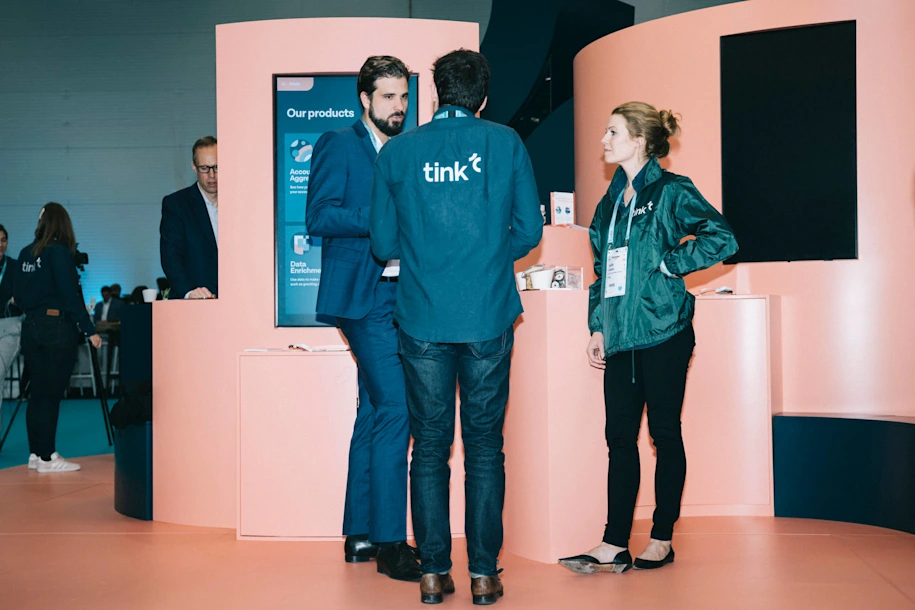4 key takeaways from Europe’s biggest financial event Money20/20

Over three days in early June, the best and brightest decision makers in the industry met at Money20/20 to discuss the biggest transformation in decades. We had substantive conversations about the future of open banking in the pink booth – and took the stage to share our vision.
Here’s what we learned:
Do we know what “open banking platform” means?
The term “platform” was as ubiquitous at Money20/20 as coffee and business cards. And no more so than when paired with the term “open banking”.
An admission right off the bat: we are offenders here too. We refer to our tech as an “open banking platform”. Internal banking systems that are used to modernise core banking services are also called “open banking platforms”. Even Eric Lassus, CEO of the bank-as-a-service startup Treezor, calls his offering an “open banking platform”.
It’s a concept that’s confusing the industry. Our first attempt at untangling it is something we’re calling an “open banking platform checklist”, and it’s coming out in a couple of weeks. It’s a buyer’s guide of sorts that lays out the criteria that really matters when picking a tech partner for this new industry landscape.
But this is just one step. What the buzzword bingo on display at Money20/20 shows is that we – the Tink “we” and the industry-wide “we” – need to more clearly define our most broadly used terms. What do we mean when we say “open banking”? What do we mean when we say “platform”? And what do we mean when we say “open banking platform”?

A focus on removing friction
It was heartening to see a chorus of keynote speakers from all corners of the industry take the stage and talk about the importance of improving the customer experience.
There was lots of talk about creating streamlined services and removing friction from the consumer perspective. And at some point, most talks resolved with something along the lines of “what really matters is meeting the needs of your customers.”
This is something that has become table stakes in payments, and has now very clearly spilled over into surrounding segments – a positive move towards more people-centric services.
But almost no one dared to speculate on what those needs actually are. And it makes sense. Everyone is rightly focused on their tiny bits and pieces of the customer experience at this early stage.
There’s another potential reason, of course, why excitement over the transformative possibilities of open banking have been tempered. And it’s the threat of the looming September deadline.

The September deadline is a freight train
Everyone is feeling the heat that the 14th September is throwing off, as evidenced in the standing-room only talk called “Open banking: lessons learned from year one.”
The panel – which included Chairman of the Financial Data and Technology Association (FDATA) Gavin Littlejohn, as well as the implementation trustee for the UK’s Open Banking organisation Imran Gulamhuseinwala – spoke about the frustration that’s plaguing both sides on the dwindling time left to comply with the PSD2 regulation.
Imran said they’ve geared up in the UK – with the added impetus from the UK’s own Open Banking legislation – and made it clear to the banks they are expected to be ready by September. But Mark Hartley, a founding partner at BankiFi and a third-party provider, said he was “very disappointed” with the state of the bank APIs at this point.
They also tackled the possibility that the customer experience could be worse after the final deadline if banks impose the “redirect” method of two-factor authentication.
“Why implement standards that require a redirect to another interface that stifles innovation?!” Mark said.
At the end of the talk, the panelists asked a question: has the banking industry embraced open banking? Given two options, the audience answered “banks have focused on compliance and knitting APIs, and precious little else.”
GAFAs making headway in the industry
While incumbents are focused on complying with regulation, the GAFAs are already making major headway in the world of payments.
Along with leaders from tech giants like Alipay and Amazon Pay, the global head of payments and financial services partnerships at Facebook was also in attendance.
Paulette Rowe gave some examples of how the social media giant is using consumer data to develop an e-commerce platform that also allows their users to make payments. And about how they’re working to enable peer-to-peer payments in its What’sApp messaging service.
It’s a prime example of how big tech is using their mounds of data to create customer-centric experiences. She also stressed that it’s a win-win for everyone when there is an open ecosystem that enables consumers to make payments in new ways – and in the places where they spend most of their time.
More in Open banking

2025-06-09
11 min read
The case for “Pay by Bank” as a global term
Thomas Gmelch argues that "Pay by Bank" should be adopted as a standard term for open banking-powered account-to-account payments to reduce confusion, build trust, and boost adoption across the industry.
Read more

2025-06-02
3 min read
Tink joins Visa A2A – what it means for Pay by Bank and VRP
Visa A2A brings an enhanced framework to Pay by Bank and variable recurring payments (VRP) in the UK, and Tink is excited to be one of the first members of this new solution.
Read more

2024-11-19
12 min read
From authentication to authorisation: Navigating the changes with eIDAS 2.0
Discover how the eIDAS 2.0 regulation is set to transform digital identity and payment processes across the EU, promising seamless authentication, enhanced security, and a future where forgotten passwords and cumbersome paperwork are a thing of the past.
Read more
Get started with Tink
Contact our team to learn more about what we can help you build – or create an account to get started right away.
